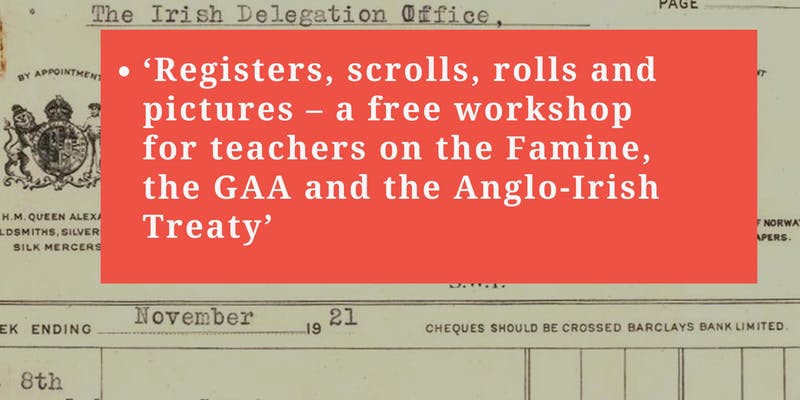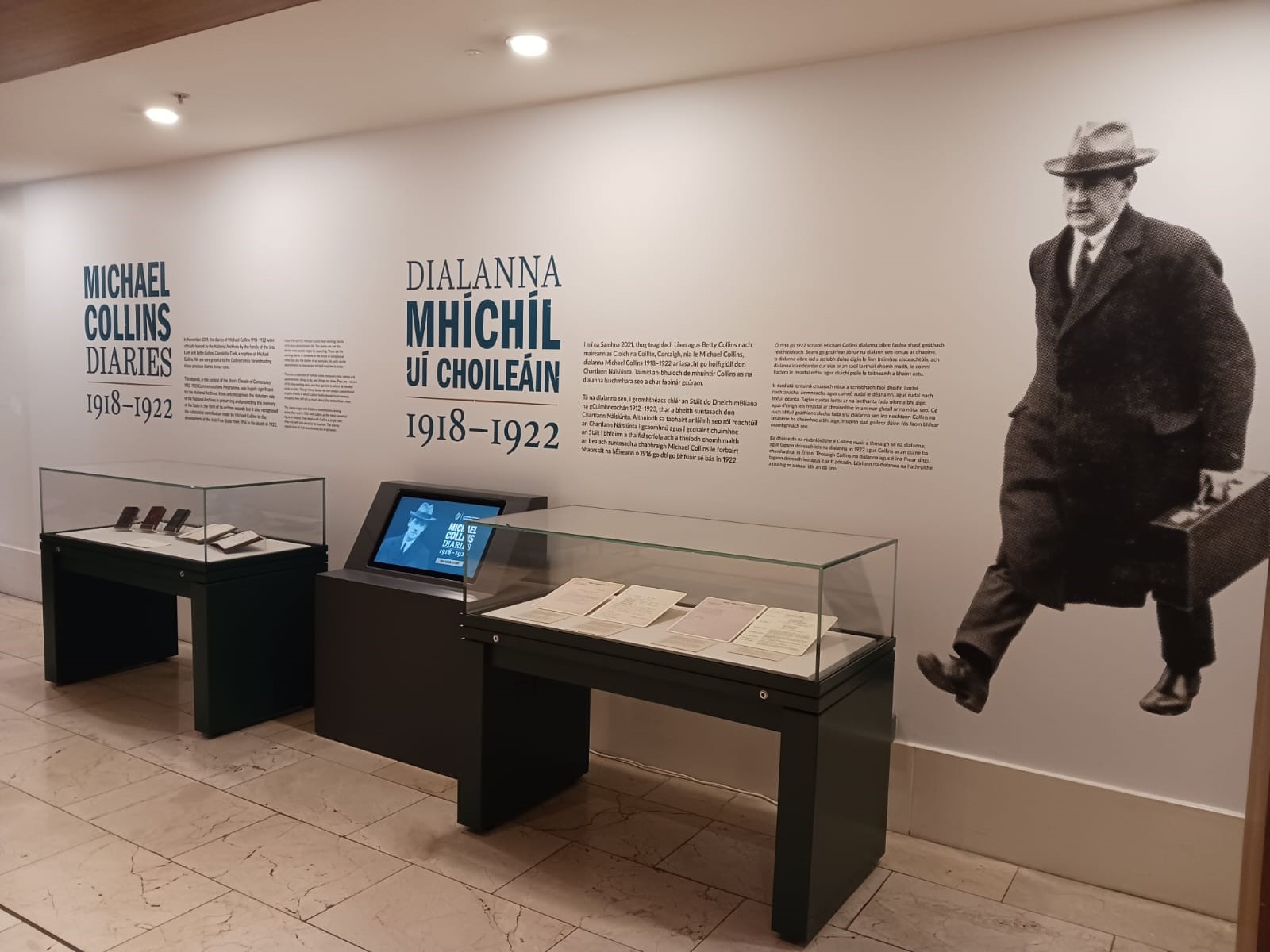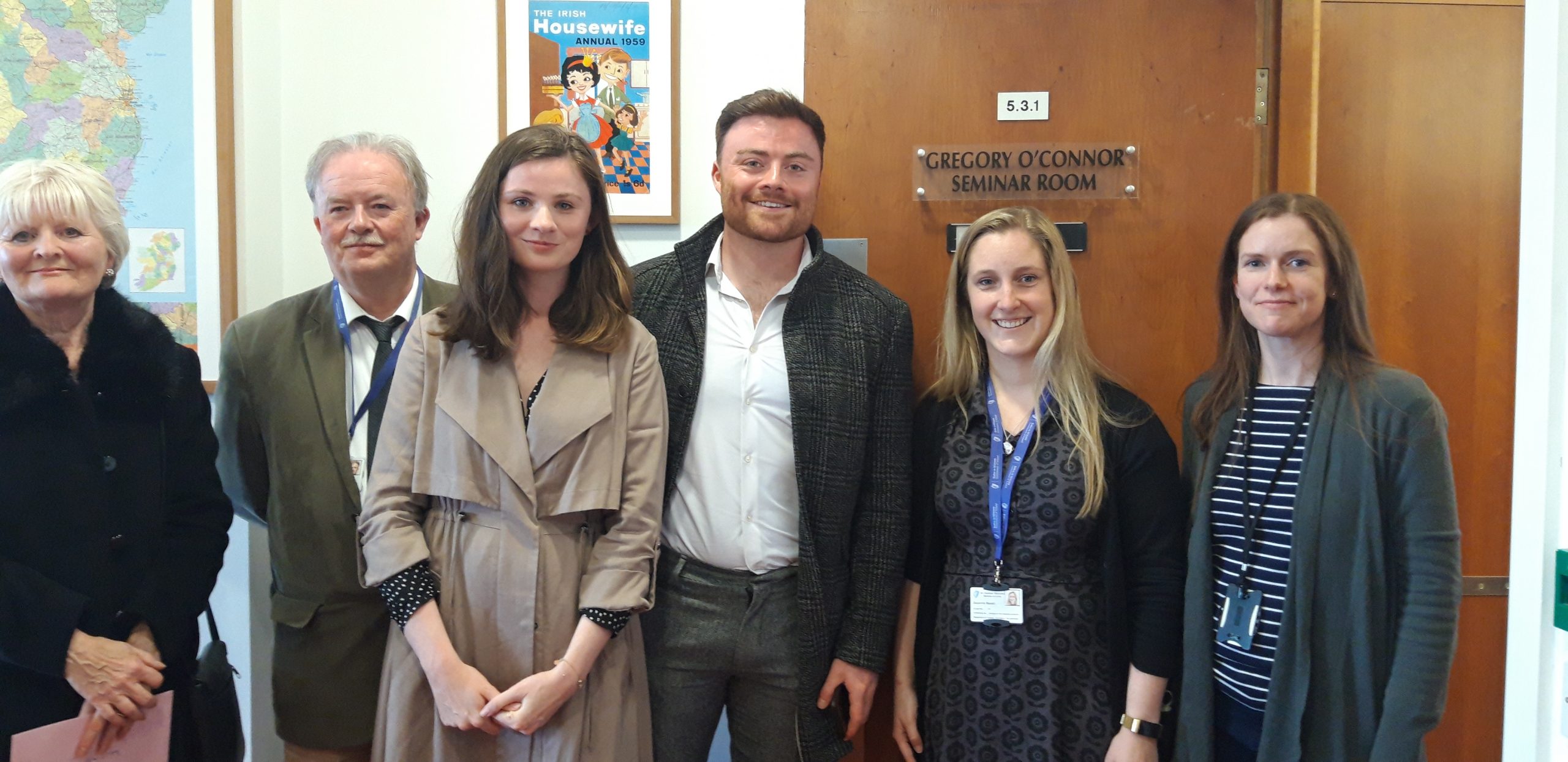Behind the Scenes
Behind the Scenes: ‘Registers, scrolls, rolls and pictures’ a workshop for history teachers

On Saturday 9th of November in collaboration with the History Teachers Association Ireland we hosted a free workshop for secondary school history teachers. The topic of the workshop were the sources held by the National Archives on the Famine, the GAA and the Treaty of 1921. Staff from the National Archives presented on how to use our sources in the classroom according to the school curriculum.
Senior Archivist and Head of Public Services Brian Donnelly gave the first presentation on ‘The Famine Sources in the National Archives 1845-1849’.
Brian opened by explaining that prior to the famine, there were numerous epidemics in Ireland which resulted in loss of life. The Mount Tambora eruption in Indonesia in 1815 resulted in the deaths of up to 150,000 people in Ireland in its aftermath. The combination of typhus and cholera which broke out as a result led to the creation of local cholera boards and fever hospitals. However, when the famine happened it was like a tsunami, overpowering the inadequate systems in place to cope with such an onslaught. The Richmond Lunatic Asylum at Grangegorman was established in 1814 and was the first of its kind in Ireland. It led to the creation of infrastructure being built around Ireland via regional district authorities.
The Chief Secretary’s Office was the centre of administration in Ireland up to Independence. During the period of the famine, the Chief Secretary’s Office Registered Papers (CSORP) were organised according to two divisions, the First and Second Divisions and these are accessible by visiting the National Archives.
Another source is the Papers of the Relief Commission, 1845-1847. The commission consisted of several hundred local committees which were in turn made up of local landowners/business owners, and clergy who came together to decide how relief should be distributed.
In 1846 the Religious Society of Friends created a Central Relief Committee to organise how they could help with famine relief. In 1846, they set up soup kitchens targeting the most vulnerable and needy. Up to £200,000 was handled by this relief body. There is a draft list of the records available in the reading room at Bishop Street.
The Office of Public Works was established in 1831. Originally known as the Board of Works, it was formed out of the merger of the Office of the Surveyor-General for Ireland, the Barracks Board, and the Navigation Board. In December 1845, it began to provide relief in the form of work projects that allowed people to work for example, construction of drainage works, piers, harbours, fisheries and road repairs. Records relating to these activities can be found in the Chief Secretary’s Office Distress Papers from March 1846 to September 1847. They are filed under “D” for distress and contain applications for money, and the establishment of relief commissions.
Another valuable source are the Irish prison registers. The level of crime increased during the escalation of the crisis of the famine, and as a result, the amount of sentences to transportation and hangings also increased. Grangegorman Prison was the first all-female prison in the British Isles. Records such as the Transportation Registers, Convict Reference Files, and CSO/Outrage Papers which are arranged by county and document the sharp rise in agrarian crime.
The Irish Poor Law was enacted in 1838 Ireland and followed the model of the British version. 130 poor law unions were created throughout the country, with at least 1 workhouse for each, sometimes many more. The National Archives holds records for the following; North Dublin Union, South Dublin Union, Rathdown Union, and Balrothery but generally poor law records are kept in the locality of where they were created.
The second talk of the morning was given by our Acting Director, Tom Quinlan, on ‘The GAA to 1891’.
Tom started off by stressing that the official records of the GAA reside in their own archive, whereas the material held by the National Archives relates to state surveillance conducted under the auspices of the Chief Secretaries Office.
Tom explained that the Chief Secretary of Ireland became increasingly important as the role of the Lord Lieutenant mutated into a more ceremonial role, meaning the Chief Secretary became the most senior British official in the country. The administration of Ireland was conducted through the Chief Secretaries Office at Dublin Castle which has resulted in an archive of approximately 1 million documents in around 4,000 archival boxes. The collection consists of incoming letters, reports, returns and memoranda to the Chief Secretary from London-based officials and Irish officials, including the police.
Tom admitted that the collection has an arcane method of access via indexes and registers making searching difficult from 1834 to its close in 1922. He said that initially he found it difficult to find references to GAA in the registers but as the organisation garnered importance they came under surveillance and the reporting increased. In the 19th century the Chief Secretaries Office were obsessed with secret societies who they were suspicious of planning to overthrow the British administration, the prominent personalities of the GAA and their nationalist allegiance meant that GAA activity was documented . Tom referenced the Crime Branch Special sub-series of the records which contains files on shadowing (or dogging as they called it in those days), and also the Dublin Metropolitan Police reports of surveillance of extremists which are available online for 1915/1916. https://www.nationalarchives.ie/article/chief-secretarys-office-crime-branch-dublin-metropolitan-police-dmp-movement-extremists-29-may-1915-20-april-1916/
The final presentation of the day was by archivist Elizabeth McEvoy which focused on sources relating to ‘The Treaty negotiations from October-December 1921’. In total ten Treaty related documents were selected from the Dáil Eireann record collection which she hoped would inspire students to analyse the documents using the “4 C’s” – comprehension, comparison, criticism and contextualisation. Elizabeth pointed out that the selected items for the workshop correspond with Topic 3 on the Leaving Certificate History syllabus. The topic was introduced by discussing the two main series of records of the Dáil Éireann collection – DE/2 and DE/4.
The Dáil Éireann 2 (DE/2) series contains administrative records of the Dáil Éireann Secretariat, 1919-1922. The series primarily consists of correspondence between the Secretary to Dáil Éireann, the Cabinet and members of the Dáil. It also includes documents generated by the administration established after the election of 1918 to support the government’s activities and material generated by the administration established after the election of 1918 to support the government’s activities and Anglo-Irish Treaty negotiations.
The Dáil Éireann 4 (DE/4) file series includes proceedings of the First and Second Dála (1919-1922) relating to session papers (departmental and committee reports); papers relating to peace negotiations; papers relating to the Committee of Information on the Case of Ulster (CICU) and the Belfast Boycott. Other types of documents that can be found in this series include correspondence, bound booklets and pamphlets.
Elizabeth highlighted common themes that arose from the Dáil Éireann collection which included key personalities on the Irish and British negotiating teams; plenipotentiary status and what this actually meant; sub-conferences used during the negotiations; tensions and conflict during the negotiations; evolution of the Irish delegates’ views as the negotiations progress; signing of the Treaty and its aftermath. Afterwards she provided several sample questions and discussion points focusing on the highlighted documents.
Elizabeth concluded her presentation by highlighting a final resource which can be used, the online Treaty exhibition. The exhibition was launched on 6 December 2011 to tie in with the 90th anniversary of the signing of the Anglo-Irish Treaty of 1921. She highlighted key features on the website such as the Irish and British delegates’ biographies which are reproduced courtesy Dictionary of Irish and Oxford National Biographies, a timeline of key events and digitised copies of original documents including a copy of the Treaty itself.


